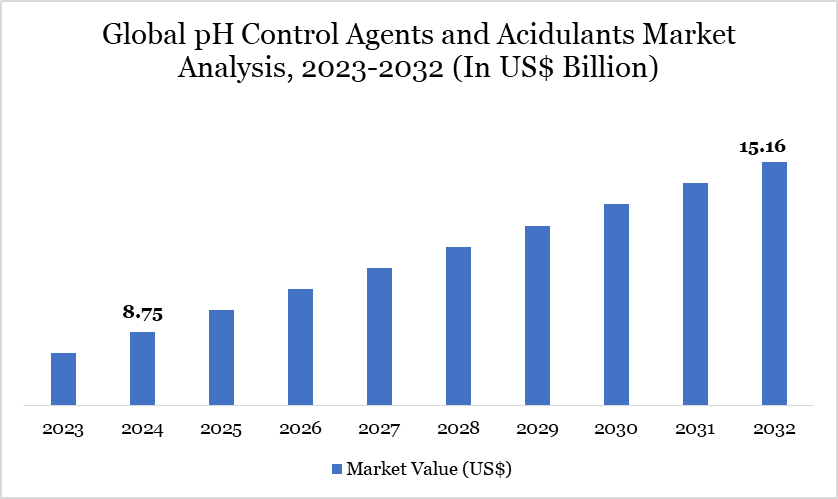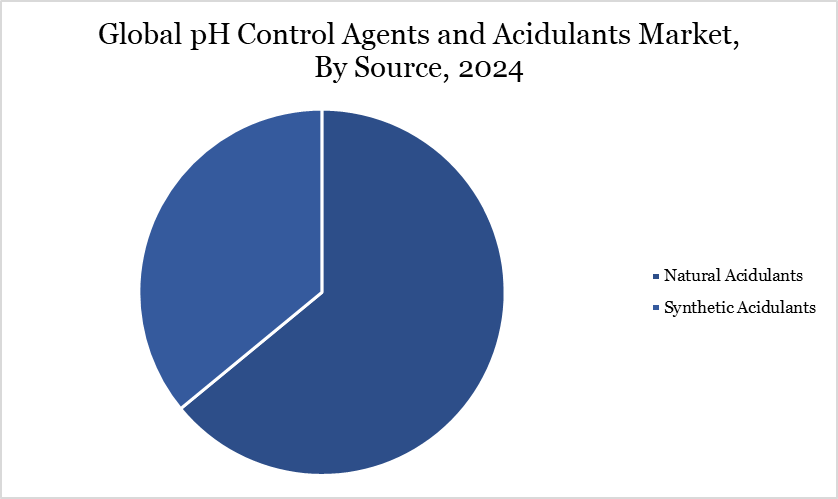pH Control Agents and Acidulants Market Size
pH Control Agents and Acidulants Market size reached US$ 8.75 billion in 2024 and is expected to reach US$ 15.16 billion by 2032, growing with a CAGR of 7.11% during the forecast period 2025-2032.
The pH control agents and acidulants market is integral to the food industry's efforts to ensure product safety, stability, and quality. According to the US Food and Drug Administration (FDA), these substances are employed to regulate acidity and alkalinity, prevent spoilage, and maintain desired taste and texture in various food products, including beverages, frozen desserts, and low-acid canned foods. The FDA's regulations mandate that acidified foods achieve a final equilibrium pH of 4.6 or below to inhibit the growth of harmful microorganisms, underscoring the critical role of acidulants in food preservation.
pH Control Agents and Acidulants Market Trend
A significant trend in the market is the shift towards natural and plant-based acidulants, such as citric and lactic acids, driven by consumer demand for clean-label products. This consumer preference aligns with regulatory bodies' emphasis on natural ingredients and sustainability. Additionally, the US Department of Agriculture (USDA) reports that in 2023, US consumers spent an average of 11.2% of their disposable personal incomes on food.
The report indicates a substantial market for food products that utilize pH control agents to ensure safety and quality. These developments highlight the market's evolution towards sustainable practices, balancing regulatory compliance with consumer expectations for natural and environmentally friendly ingredients.

For more details on this report - Request for Sample
Market Scope
| Metrics | Details |
| By Type | Organic Acidulants, Inorganic Acidulants, Blended Acidulants |
| By Source | Natural Acidulants, Synthetic Acidulants |
| By Function | pH Stabilization, Flavor Enhancement, Preservation & Shelf-life Extension, Texture Modification |
| By Application | Food and Beverages, Pharmaceuticals, Personal Care, Industrial Applications |
| By Region | North America, South America, Europe, Asia-Pacific and Middle East and Africa |
| Report Insights Covered | Competitive Landscape Analysis, Company Profile Analysis, Market Size, Share, Growth |
pH Control Agents and Acidulants Market Dynamics
Innovation and Sustainability in the pH Control Agents Market
As the global food, beverage and pharma industry increasingly shifts toward sustainability, the demand for natural, eco-friendly ingredients is reshaping the landscape of food additives, particularly in the sector. The market for pH control agents, including acidulants, is one area where this transformation is most visible. In response to growing consumer preference for healthier, cleaner-label products, manufacturers are also introducing new and innovative products into the market.
For instance, in August 2024, Anhui Huaheng Biotechnology introduced Bioscentis MA, a bio-based L-malic acid that offers a sustainable and innovative solution for the confectionery industry. This acidulant provides a smooth, long-lasting sour flavor with 1.2 times the acidity of citric acid, delivering a balanced, apple-like taste ideal for modern candy formulations. Bioscentis MA enhances flavor while meeting the growing demand for eco-friendly, natural ingredients.
Price Volatility of Raw Materials
Many acidulants and pH control agents, such as citric acid (derived from citrus fruits) and lactic acid (produced via fermentation), rely heavily on natural resources. The availability and cost of these raw materials are subject to fluctuations due to several factors, including agricultural conditions, climate variability and trade policies. These fluctuations can lead to price instability in the production of pH control agents and acidulants.
Additionally, cost pressure on manufacturers arises when raw material prices increase, directly impacting the production costs of these chemicals. As a result, manufacturers may face challenges in maintaining profitability, as higher production costs can lead to increased prices for end consumers or reduce profit margins. The dependency on natural resources, combined with external factors affecting their supply, contributes to significant market volatility and challenges in price forecasting.
pH Control Agents and Acidulants Market Segment Analysis
The global pH control agents and acidulants market is segmented based on type, source, function, application and region.

Natural Acidulants Segment Driving pH Control Agents and Acidulants Market
The global pH control agents and acidulants market is segmented based on type into natural and synthetic. Natural acidulants are gaining momentum with the growing demand for clean-label products those free from artificial additives and chemicals have led manufacturers to seek natural alternatives. Natural acidulants, such as citric acid from citrus fruits or malic acid from apples, align with consumer preferences for organic, non-GMO and sustainably sourced ingredients.
Additionally, the rise in health consciousness and the popularity of functional foods and beverages, such as probiotics, nutritional supplements and low-sugar alternatives, is driving the demand for natural acidulants. These ingredients are not only considered safer but also contribute to the overall appeal of products marketed as natural or clean. As consumers increasingly prioritize sustainability and traceability in food production, natural acidulants are becoming a preferred choice for manufacturers.
pH Control Agents and Acidulants Market Geographical Share
Demand for pH Control Agents and Acidulants in North America
The demand for pH control agents and acidulants in North America is experiencing significant growth, driven by several key factors. The US Food and Drug Administration (FDA) enforces stringent regulations on the use of acidulants in food and beverages, requiring manufacturers to adhere to specific limits and specifications to ensure consumer safety. This regulatory emphasis aligns with the growing consumer demand for clean-label products, driving manufacturers to reformulate offerings with plant-based acidulants derived from sources such as citrus fruits and berries.
Additionally, the US Department of Agriculture (USDA) reports that processed food expenditures in the US exceeded $1.1 trillion in 2022, accounting for 65% of total food spending, highlighting the significant role of acidulants in the food processing sector. These developments underscore the market's shift towards sustainable practices, balancing regulatory compliance with consumer expectations for natural and environmentally friendly ingredients.
Sustainability Analysis
The sustainability of the pH control agents and acidulants market is increasingly influenced by regulatory frameworks and consumer preferences for natural ingredients. In the US, the Food and Drug Administration (FDA) enforces stringent regulations on the use of acidulants in food and beverages, requiring manufacturers to adhere to specific limits and specifications to ensure consumer safety.
Similarly, the European Food Safety Authority (EFSA) evaluates the safety of acidulants and sets acceptable daily intake levels, promoting the use of natural acidulants like citric and lactic acids over synthetic alternatives. This regulatory emphasis aligns with the growing consumer demand for clean-label products, driving manufacturers to reformulate offerings with plant-based acidulants derived from sources such as citrus fruits and berries. These developments underscore the market's shift towards sustainable practices, balancing regulatory compliance with consumer expectations for natural and environmentally friendly ingredients.
pH Control Agents and Acidulants Market Major Players
The major global players in the market include Cargill, Incorporated, ADM, Corbion N.V., Jungbunzlauer Suisse AG, Merck KGaA, Wang Pharmaceuticals and Chemicals, CheMondis GmbH, Jaysons Chemical Industries, Vinipul Inorganics India Pvt. Ltd and JIAAN BIOTECH.

Key Developments
In 2023, Tate & Lyle PLC introduced a new range of clean-label pH control agents, while Jungbunzlauer AG announced a partnership to develop a biobased plasticizer. Specifically, Jungbunzlauer partnered with Green Biologics to produce biobased plasticizers. Tate & Lyle's new pH control agents are part of their efforts to provide solutions for reduced sugar and healthier food and drink
Why Choose DataM?
Data-Driven Insights: Dive into detailed analyses with granular insights such as pricing, market shares and value chain evaluations, enriched by interviews with industry leaders and disruptors.
Post-Purchase Support and Expert Analyst Consultations: As a valued client, gain direct access to our expert analysts for personalized advice and strategic guidance, tailored to your specific needs and challenges.
White Papers and Case Studies: Benefit quarterly from our in-depth studies related to your purchased titles, tailored to refine your operational and marketing strategies for maximum impact.
Annual Updates on Purchased Reports: As an existing customer, enjoy the privilege of annual updates to your reports, ensuring you stay abreast of the latest market insights and technological advancements. Terms and conditions apply.
Specialized Focus on Emerging Markets: DataM differentiates itself by delivering in-depth, specialized insights specifically for emerging markets, rather than offering generalized geographic overviews. This approach equips our clients with a nuanced understanding and actionable intelligence that are essential for navigating and succeeding in high-growth regions.
Value of DataM Reports: Our reports offer specialized insights tailored to the latest trends and specific business inquiries. This personalized approach provides a deeper, strategic perspective, ensuring you receive the precise information necessary to make informed decisions. These insights complement and go beyond what is typically available in generic databases.
Target Audience 2024
Manufacturers/ Buyers
Industry Investors/Investment Bankers
Research Professionals
Emerging Companies
